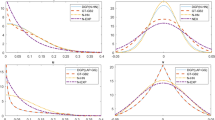Abstract
This paper uses Monte Carlo experimentation to investigate the finite sample properties of the maximum likelihood (ML) and corrected ordinary least squares (COLS) estimators of the half-normal stochastic frontier production function. Results indicate substantial bias in both ML and COLS when the percentage contribution of inefficiency in the composed error (denoted by γ*) is small, and also that ML should be used in preference to COLS because of large mean square error advantages when γ* is greater than 50%. The performance of a number of tests of the existence of technical inefficiency is also investigated. The Wald and likelihood ratio (LR) tests are shown to have incorrect size. A one-sided LR test and a test of the significance of the third moment of the OLS residuals are suggested as alternatives, and are shown to have correct size, with the one-sided LR test having the better power of the two.
Similar content being viewed by others
References
Aigner, D.J., and S.F. Chu. (1968). “On Estimating the Industry Production Function.”.American Economic Review, 58, 826–839.
Aigner, D.J., C.A.K. Lovell and P. Schmidt. (1977). “Formulation and Estimation of Stochastic Frontier Production Function Models.”Journal of Econometrics, 6, 21–37.
Baltagi, B., Y. Chang and Q. Li. (1992). “Monte Carlo Results on Several New and Existing Tests for the Error Components Model.”Journal of Econometrics, 54, 95–120.
Banker, R.D., A. Charnes, W.W. Cooper and A. Maindiratta. (1988). “A Comparison of DEA and Translog Estimates of Production Functions Using Simulated Data from a Known Technology.” In A. Dagramaci and R. Färe (eds.),Applications of Modern Production Theory: Efficiency and Productivity, Boston: Kluwer.
Battese, G.E. and Coelli, T.J. (1988). “Prediction of Firm-Level Technical Efficiencies with a Generalized Frontier Production Function and Panel Data.”Journal of Econometrics, 38, 387–399.
Battese, G.E. and G.S. Corra. (1977). “Estimation of a Production Frontier Model: With Application to the Pastoral Zone of Eastern Australia.”Australian Journal of Agricultural Economics, 21, 169–179.
Bauer, P.W. (1990). “Recent Developments in the Econometric Estimation of Frontiers.”Journal of Econometrics 46, 39–56.
Bravo-Ureta, B.E. and A.E. Pinheiro. (1993). “Efficiency Analysis of Developing Country Agriculture: A Review of the Frontier Function Literature.”Agricultural and Resource Economics Review, 22, 88–101.
Coelli, T.J. (1992). “A Computer Program for Frontier Production Function Estimation: FRONTIER Version 2.0”Economics Letters, 39, 29–32.
Coelli, T.J. (1993).Finite Sample Properties of Stochastic Frontier Estimators and Associated Test Statistics, Working Papers in Econometrics and Applied Statistics, No. 70, University of New England, Armidale.
Coelli, T.J. (1995). “A Monte Carlo Analysis of the Stochastic Frontier Production Function.” Mimeo, Department of Econometrics. University of New England, Armidale.
D'Agostino, R.B. and E.S. Pearson. (1973). “Tests for Departure from Normality: Empirical Results for the Distribution ofb 2 and\(\sqrt {b_1 } \).”Biometrika, 60, 613–622.
Gong, B. and R.C. Sickles. (1989). “Finite Sample Evidence on the Performance of Stochastic Frontier Model Using Panel Data.”Journal of Productivity Analysis, 1, 229–261.
Gong, B. and R.C. Sickles. (1992). “Finite Sample Evidence on the Performance of Stochastic Frontiers and Data Envelopment Analysis Using Panel Data.”Journal of Econometrics, 51, 259–284.
Gourieroux, C., A. Holly and A. Monfort. (1982). “Likelihood Ratio Test, Wald Test, and Kuhn-Tucker Test in Linear Models with Inequality Constraints on the Regression Parameters.”Econometrica, 50, 63–80.
Greene, W.H. (1992).LIMDEP Version 60: User's Manual and Reference Guide, Econometric Software Inc., New York.
Greene, W.H. (1993). “The Econometric Approach to Efficiency Analysis.” In H.O. Fried, C.A.K. Lovell and S.S. Schmidt (eds.),The Measurement of Productive Efficiency, New York: Oxford University Press, 68–119.
Honda, Y. (1985). “Testing the Error Components Model with Non-Normal Disturbances.”Review of Economic Studies, 52, 681–690.
Jensen, U. (1993).Measuring Individual Inefficiency with Frontier Functions: A Monte Carlo Study. Discussion Paper 68, Institut für Statistic und Okonometrie, der Universität Kiel, Kiel.
Judge, G., W. Griffiths, R. Carter-Hill, H. Lutkepohl and T. Lee. (1985).The Theory and Practice of Econometrics, Second Edition, New York: Wiley.
Lee, L.F. (1993). “Asymptotic Distribution of the Maximum Likelihood Estimator for a Stochastic Frontier Function Model with a Singular Information Matrix.”Econometric Theory, 9, 413–430.
Meeusen, W. and J. van den Broeck. (1977). “Effciency Estimation from Cobb-Douglas Production Functions with Composed Error.”International Economic Review, 18, 435–444.
Olsen, J.A., P. Schmidt and D.M. Waldman. (1980). “A Monte Carlo Study of Estimators of the Stochastic Frontier Production Function.”Journal of Econometrics, 13, 67–82.
Pagan, A.R. and A.D. Hall. (1983). “Diagnostic Tests as Residual Analysis.”Econometrics Reviews, 2, 159–218.
Pitt, M.M. and L.-F. Lee (1981). “Measurement and Sources of Technical Inefficiency in the Indonesian Weaving Industry.”Journal of Development Economics 9, 43–64.
Richmond, J. (1974). “Estimating the Efficiency of Production.”International Economic Review, 15, 515–521.
Schmidt, P. and T. Lin. (1984). “Simple Tests of Alternative Specifications in Stochastic Frontier Models.”Journal of Econometrics, 24, 349–361.
Schmidt, P. and C.A.K., Lovell. (1979). “Estimating Technical and Allocative Inefficiency Relative to Stochastic Production and Cost Function.”Journal of Econometrics 9, 343–366.
Stevenson, R.E. (1980). “Likelihood Functions for Generalized Stochastic Frontier Estimation.”Journal of Econometrics, 13, 57–66.
Tran, S.V.H., T. Coelli and E. Fleming. (1993) “Analysis of the Technical Efficiency of State Rubber Farms in Vietnam.”Agricultural Economics, 9, 183–201.
Waldman, D. (1982). “A Stationary Point for the Stochastic Frontier Likelihood.”Journal of Econometrics, 18, 275–280.
White, K. (1993).SHAZAM User's Reference Manual Version 7.0 New York: McGraw-Hill.
Author information
Authors and Affiliations
Additional information
The author would like to thank Bill Griffiths, George Battese, Howard Doran, Bill Greene and two anonymous referees for valuable comments. Any errors which remain are those of the author.
Rights and permissions
About this article
Cite this article
Coelli, T. Estimators and hypothesis tests for a stochastic frontier function: A Monte Carlo analysis. J Prod Anal 6, 247–268 (1995). https://doi.org/10.1007/BF01076978
Issue Date:
DOI: https://doi.org/10.1007/BF01076978




